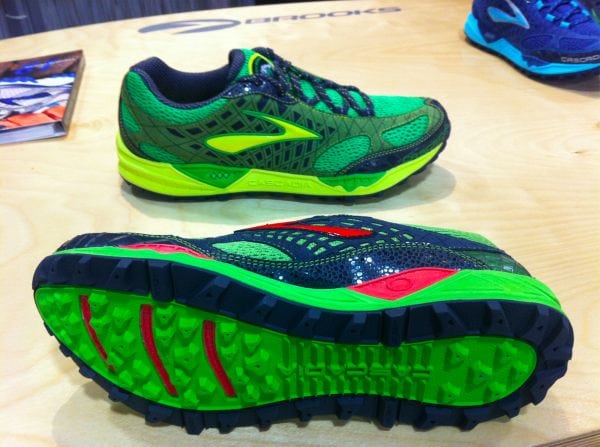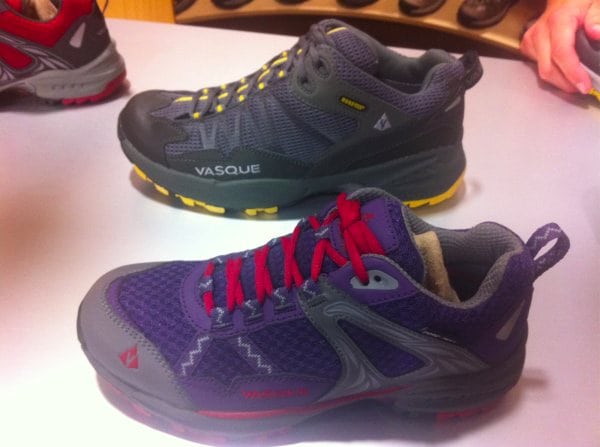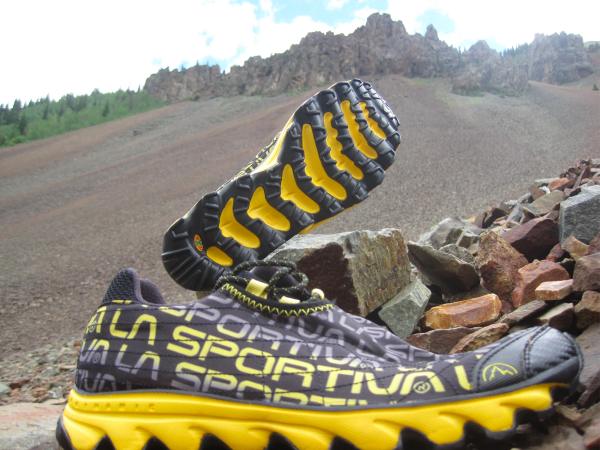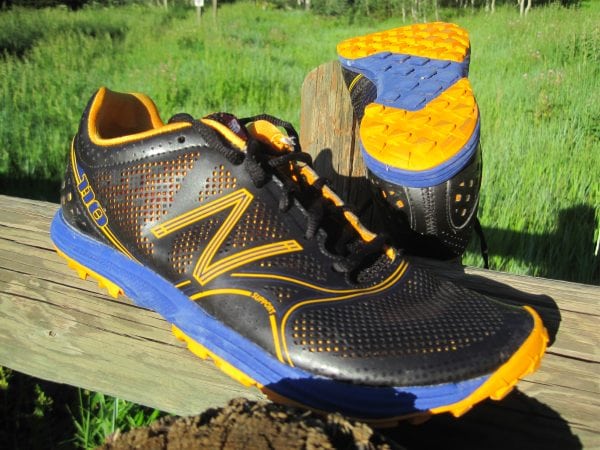Every August, Salt Lake City sees the announcement of the vast majority of the following year’s top trail running shoes at the Outdoor Retailer show. This year was no exception. From barebones minimalist to comfy zero drop shoes, from everyday hybrid trail runners to sleek new racing shoes, I saw a closet’s worth of shoe-lust worthy trail running shoes. Here’s a look at some of my favorite models. Additional photos of many models can be found in iRunFar’s Facebook album for the show.
For easier navigation, we’ve added links that jump down directly to the following previews:
- New Balance Minimus Trail Zero – MT00
- Brooks PureGrit
- Montrail Rogue Fly
- The North Face Hayasa
- Altra Lone Peak
- Brooks Cascadia 7
- Hoka One One Stinson B Evo
- Merrell Glove Line Extensions
- New Balance Minimus Road Zero – MR00
- Salomon XR Mission
- SCARPA Spark
- Vasque Velocity 2.0
- Vibram Spiridon LS
- La Sportiva Vertical K
- Montrail Bajada
- New Balance MT110
New Balance Minimus Trail Zero – MT00 ($100 – February 2012)
[Update: We now have a full review of the New Balance Minimus Trail Zero.]
The NB Minimus Trail has been a big hit and New Balance is ready to take the next step with the MT00, aka the Minimus Trail Zero. (Don’t worry Minimus fans, both the current Minimus Trail and Minimus Road, with their 4 mm drops, will remain in the line.) To start, the Minimus Trail Zero gets its namesake feature in a zero drop platform. This minimalist approach has been extended from the midsole into the outsole where New Balance looked at couple dozen pairs of used standard Minimus Trails to determine the 10 most worn lugs. NB then used that data to selectively cover only the most worn lugs with outsole rubber while leaving the midsole exposed. In addition, the Minimus Trail outsole was also reduced by coring out the outsole rubber down to the midsole in the hollows between the lugs.
The upper is radically different. It’s primarily made from one piece of a fabric that seems more like nylon than running shoe mesh. That material is thin enough that you can see your toes through the upper. That upper is fleshed out by one piece of overlay; very small reinforcements at the toe, eyelets, and heel; and slight padding in the ankle collar and heel. There’s a soft, single-layer synthetic tongue with flat laces to reduce lace bite. The eyerow has been reduced from 6 to 5 eyelets. The lasting is similar to the current Minimus Trail… but with a zero drop.
All of these changes yield a 4.4 ounce shoe!
Here are 9 things you should know about the Minimus Zero straight from New Balance.
New Balance Minimus Trail Zero – MT00 ($100 – October 1, 2011)
[Update: We now have a full review of the Brooks PureGrit.]
There’s been quite a bit of chatter in the trail running ranks about Brooks’ PureProject and, particularly, the trail-specific shoe in the project, the PureGrit. That buzz isn’t surprising considering the historic popularity of the Brooks Cascadia and the current trend toward minimalism. Brooks’ goal with the PureProject line is to “promote your natural stride.”
So what’s the Brooks PureGrit? An 8.4 (or is it 8.9) ounce (US men’s 9, 7.6 oz for women’s 7) low to the ground (15 mm heel, 11 mm toe) 4 mm drop trail specific shoe designed, like the Cascadia, with input from Scott Jurek.
According to Brooks, the five main tech features of the PureGrit:
- Ideal heel – An extremely curved heel that prevents you from landing behind the center of the heel/ankle joint.
- Nav Band – An elastic band across the laces to create a more secure fit.
- Toe Flex – The sole and upper surrounding the big toe are separate from the other toes allowing for better ground feel and response.
- Midsole Foam – Brooks has blended in its DNA midsole compound throughout the midsole to respond to a runner’s need.
- Anatomical Last – A different last than used for the Cascadia that has a more curved, foot-like shape.
The shoe has a generally convex outsole that provides great feel and allows 2-4mm of splay in the outsole to provide additional traction. There’s no rockplate, but an aggressive outsole that runs the length of the shoe (i.e., no cut outs) for protection. Brooks added a center strike zone “pod” to inform the foot where the center of the shoe is. The highly permeable light-mesh upper that lets water in… but let’s it right back out. The tongue is padded only in the center, which I like as it saves weight without losing function or sacrificing comfort.
Montrail Rogue Fly ($120 – February 1, 2012)
What happens when you strip down the already lean Montrail Rogue Racer? You get the Montrail Rogue Fly! Both models use exactly the same outsole, midsole, and rockplate, but at 7.6 ounces for a US men’s, the Rogue Fly is 13% (1.2 ounces) lighter than the Rogue Racer. All that weight savings comes from stripping the already light Rogue Racer upper down ever further. The upper consists of two pieces of mesh and a tongue. That’s just about it. There aren’t any overlays with the exception of a small heel overlay for structure nor is there any under webbing across the metarsals from the midsole to the eyelets. While this is a racing shoe, it’s not meant to be run in sockless. The Rogue Fly has a 10 mm drop with 18mm at the heel and 8 mm at the forefoot, just like the Rogue Racer.
The North Face Hayasa ($110 – Spring 2012)
Last year, The North Face created a great trail running platform in the Single-Track. If TNF beefed up Single-Track into the Double-Track this year, then next year it’s putting its flagship model on a diet in the form of the Hayasa![]() (“speed” in Japanese). In the Hayasa, The North Face have built an 8.3 ounce (US men’s 9) shoe that doesn’t sacrifice protection. To save weight, TNF dropped the midsole to 18mm in the heel and 8 mm in the forefoot (10 mm drop) and by minimizing the upper which now features a “geodesic cradle” to lock your foot in place. The upper looks supportive, lightweight, and quite breathable. Seams have been minimized in this neutral trail runner that gets stability from a heel cup and support from a midfoot shank.
(“speed” in Japanese). In the Hayasa, The North Face have built an 8.3 ounce (US men’s 9) shoe that doesn’t sacrifice protection. To save weight, TNF dropped the midsole to 18mm in the heel and 8 mm in the forefoot (10 mm drop) and by minimizing the upper which now features a “geodesic cradle” to lock your foot in place. The upper looks supportive, lightweight, and quite breathable. Seams have been minimized in this neutral trail runner that gets stability from a heel cup and support from a midfoot shank.
This shoe excited me when I first was it in January at winter OR and I’m even more excited now that I’ve had a chance to slip it on my foot. The Hayasa is a giant leap forward for The North Face.
Additional Shoes
I’d originally intended to intended the following to be briefer previews of a larger set of sweet new shoes I saw at summer OR. So much for briefer! Read on for another dozen shoe previews!
Altra Lone Peak ($99 in specialty running stores/$105 online – November 2011)
[Update: We now have full review of the Altra Lone Peak.]
At this point, you might think you’ve seen every iteration of zero-drop trail running shoe… but that’s not true unless you’ve send the Altra Lone Peak. The shoe (along with its roady cousin, the Instinct) was designed by long-time runners and running store employees along Utah’s Wasatch Front who were “zeroing” shoes by detaching outsoles, grinding down midsoles, and reattaching the outsoles well before others were talking about drop, let along zero drop. Anyway, these guys have created a line of fully cushioned zero drop running shoes with a rockplate inset into the midsole layers and a “mud rudder” rear outrigger a la the early 90s Adidas Trail Response. They claim that the 9.9 ounce Lone Peak has the same protection as a Brooks Cascadia while running like a New Balance MT101 or Montrail Rogue Racer.
Brooks Cascadia 7 ($110 – February 1, 2012)
[Update: We now have a full review of the Brooks Cascadia 7.]
It’s safe to say that I’ve never been more excited about the seventh iteration of a shoe. The Cascadia 4 may still be my favorite trail shoe of all time, while the Cascadia 6 didn’t live up to my admittedly very high expectations. I still love the Cascadia 6 on nearly all terrain, so please don’t think I dislike the shoe. It’s still on the top row of my shoe rack. My primary concern with the Cascadia 6 was reserved for steep or technical downhills during which the upper would let my foot shift forward. I was far from the only one to note this. It’s my belief that the two “floating” medial (instep) eyelets did their job in relieving pressure on the top of the foot a little too well. Fortunately, those eyelets are now secure and I’ll be psyched to get into the Cascadia 7.
… and the rest of the scoop on the Cascadia 7? It uses the same rockplate and the same midsole, including the BioMoGo DNA material, at the Cascadia 6, but the outsole has been updated. Brooks was getting feedback about outsole wear, so they’ve replaced the 6’s circular saw lugs with a more durable lug configuration. In the end, the weight (12.2 oz for US men’s 9) will be very similar to that of Cascadia 6, with the weight of the upper being reduced and that of the outsole being increased.
Hoka One One Stinson B Evo ($170 – February 2012)
Out on the trail all Hokas might look the same, but the models are quite a bit different. With its forthcoming Stinson B Evo takes many of its lessons from the Mafate and Bondi B to make, what I think, is a much improved shoe. The outsole shape is somewhere between the Mafate and Bondi B, but the bit changes come with the outsole details and midsole structure. First off, the lug height on the Stinson B has been increased and, therefore, so has the shoe’s traction. A combination of new flex grooves in the outsole and a change in the midsole compound give the shoe more flex making it much more responsive than previous models.
The Stinson comes with a speed lacing system as well as traditional laces. In addition, the shoe will come with both a thin and think insole. In addition, the Stinson B is designed to be “tuned” by individual runners by drilling thin holes in the particular areas of the midsole where they would like the shoe to be softer such that the foot will travel more in that direction.
Merrell Glove Line Extensions
I believe I overheard at the show that the Merrell Trail Glove is currently the top selling trail shoe in America. Whether or not that’s true, the Merrell Glove line has jumped out of the gate and continues to barrel along. Here are some updates to the line.
Merrell Trail Glove
Merrell will be adding widths to its popular Trail Gloves.
Merrell Road Glove ($110 – February 2012)
Merrell will be adding a road shoe fittingly coined the Road Glove. Both the men’s and women’s specific models will have a wider forefoot than the Trail Glove to allow for more toe splay. Unsurprisingly, Merrell took out its 1 mm rockplate, thus allowing for more flex and greater ground feel, and incorporated a smoother outsole.
Merrell Bare Access ($90 – February 2012)
For those looking for a more comfortable transition to barefoot or minimalist running, Merrell’s releasing a cushioned zero drop shoe, the Merrell Bare Access with 8 mm of cushioning.
New Balance Minimus Road Zero – MR00 ($110 – February 2012)
[Update: We now have a full review of the New Balance Minimus Road Zero.]
New Balance will also be releasing a 6.4 ounce, zero drop road shoe in the Minimus Road Zero or MR0o. This shoe has a rubber outsole covering 50-60% of the shoe’s bottom (according to my highly unscientific eyeball measurement) that accommodates a midfoot strike. This will be the first New Balance road runner with a Vibram outsole, which has softer rubber and greater flexibility. There are low, flat lugs and, just as in the MR10, a Revlite midsole. The one piece upper is more substantial than the MT00, but still includes minimal overlays. There’s a “burrito tongue” wrapped from the medial (instep) side. The eyelets have been reduced from 6 in the MR10 to 4 in the MR00.
Salomon XR Mission ($110 – February 1, 2012)
Salomon continues to expand its trail running line with the XR Mission![]()
, a door-to-trail shoe in the vein of this year’s XR Crossmax. The XR Mission is ever so slightly lower to the ground than the Crossmax (20mm-10mm vs 21mm-10mm) and is intended as more of a workout shoe whereas the Crossmax would be an everyday trainer. Unlike the Crossmax, there is one version rather than one neutral and one guidance version. However, the men’s and women’s models are distinctly different based on Salomon lab testing. The women’s shoe has deeper flex grooves, different heels to accommodate a woman’s Q angle, and different Sensiflex panels in response to the fact that a woman’s foot changes shape 20% more than a man’s during running.
Saucony Peregrine 2 ($100 – March 1, 2012)
Earlier this year, we reviewed the Saucony Peregrine. Next year, Saucony is releasing the Peregrine 2 and they’re not messing too much with a good thing. The shoe remains the trail version of the company’s popular Kinvara model. Weighing in at 9.9 ounces for a US men’s 9 (down from 10.1 ounces), the main theme of the update is a reduced upper, which will feature fewer seams, fewer overlays, and, therefore, fewer pressure points, including the removal of the center seam over the toes. Word is they also improved the ankle collar lining.
SCARPA Spark ($115 – Spring 2012)
Next spring, SCARPA is releasing its lightest ever trail running shoe, the Spark. At 9.5 ounces, SCARPA considers this a race ready shoe that embodies its “mountain minimal” concept, which seeks to reduce shoes to their basics while still providing adequate protection. The shoe features a high tensile fabric forefoot for push through protection and either a 6 or 8 mm drop.
Vasque Velocity 2.0 ($120/$150 with GORE-TEX – January 15, 2012)
A full decade ago, Vasque released the Velocity, which was a major step forward in runnability for trail runners. With recent trends, the Velocity has gone from being classified as a trail runner to a light hiking shoe. The Vasque Velocity 2.0 stays true to its heritage while bringing the model back to the running scene. The shoe still has a full-length protective shank and a very aggressive outsole. However, the upper was greatly reduced by removing overlays and using more mesh and the medial post was removed making this a more neutral shoe. The shoe’s also lower to the ground with the heel dropping 3 mm and the forefoot dropping 2 mm.
Vibram Spiridon LS ($120 – February 1, 2012)
Admittedly, I’m neither a barefoot nor a barefoot-style runner, but I thought many of you would want to hear about Vibram’s first dedicated FiveFinger trail running shoe. This 6.8 ounce (US men’s 9; 5.1 ounce US women’s 7) shoe has a 6 mm stack height throughout with a 3.5 mm outsole. There are more lugs than other Vibram running models and these lugs are both more textured and include more edging to improve bite into the ground. The Spiridon LS features a “3D Cocoon,” a very strong nylon textile that’s baked into the sole to disrupt impact. The 3D Cocoon runs the length of the shoe. The shoe includes a slightly beefier upper that includes significant toe bumpers. The Spiridon LS is a lace up rather than velcro model.
In addition, Vibram will also be releasing the SeeYa, a 4.8 ounce “performance model” for dedicated minimalist runners. It’s got a significantly reduced upper as well as a Bikila informed outsole with the midfoot and some other portions cut away. Even the velcro straps have cutouts to reduce weight. I’ll assume that all those interested will have seen this model in the barefooting corners of the internet.
Previously Previewed Spring/Summer 2012 Models
La Sportiva Vertical K ($115 – Spring 2012)
We’ve already previewed the La Sportiva Vertical K, the sweet new 6.5 ounce racing shoe born in the Italian Dolomites. Sportiva has paired an minimal yet supportive upper with its light, highly absorbent MorphoDynamic midsole/outsole system. The result? A highly flexible, protective, ultralight mountain racing shoe.
Montrail Bajada ($115 – Spring 2012)
[Update: Here’s our review on the Montrail Bajada. We liked the Bajada enough that we’re selling it.]
Montrail’s forthcoming Bajada is my favorite trail running shoe to come along in the past couple years. Why? It’s a real, supportive, protective trail shoe that weighs in at only 10 ounces even. For me, that’s in my everyday as well as my 100 miler sweet spot. I wore these for the final 80 miles at Western States and plan to run The North Face Ultra-Trail du Mont-Blanc in them.
New Balance MT110 ($85 – January 2012)
[Update: We’ve now published a technical preview, a full review, and a “The Making of” story (including interviews with Anton Krupicka and Erik Skaggs) for the New Balance MT110.
The New Balance MT110 is the follow up to the company’s popular MT101 model. However, this is no minor update like the transition from the MT100 to MT101 was. With the MT110, New Balance lowered the heel-toe drop from 10mm to 4mm. That’s a big change, but so are the redesigned outsole (grippier) and upper (shinier).
Call for Comments
Not sure I even have to call for comments here, but … ready, set, have at it!
(Ps. What spring/summer 2012 trail running shoe are you most excited about?!)




















